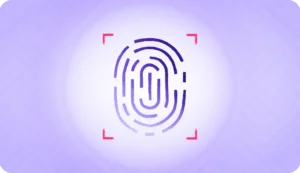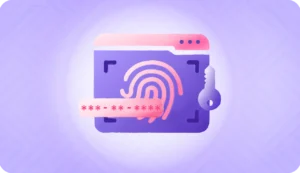Biometrics is changing how we verify identity and secure our digital world. From unlocking smartphones with a fingerprint to facial recognition at airport security, these advanced identity verification methods every second are transforming how we interact with technology and protect personal information.
In the United States, biometric systems are no longer just a futuristic concept but a current reality. Government agencies, corporations, and tech companies are increasingly adopting these systems to enhance security and reduce fraud.
The global biometric technologies, currently valued at ~$47 billion are expected to touch ~$85 billion by 2029, growing at a 12.3% CAGR from 2024! What’s more? Artificial Intelligence (AI), Machine Learning (ML), and advanced sensors are making identification systems more accurate, and faster, pushing the boundaries of what’s possible.
So, as we stand on the brink of a revolution in the identity verification industry, understanding the future of biometrics, its innovations, and its implications has never been more important. In this article, we explore the emerging technology in biometrics in different industries and their implication.
What is biometrics and why is it important?
Biometrics uses advanced technology to identify people using their unique physical or behavioral characteristics. Think of it as a digital fingerprint that goes beyond traditional passwords or ID cards. Instead of remembering complex codes, your body becomes the key.
At its core, biometrics captures and analyzes distinctive human traits such as:
- Fingerprints: The unique ridges and patterns on your fingertips
- Iris scans: The intricate patterns in the colored part of your eye
- Facial recognition: The specific measurements and contours of your face
- Voice patterns: The unique sound and rhythm of your voice
- Behavioral traits: How you walk, type, or even signature style
Biometric systems capture a person’s traits, convert them into digital data, and compare it with pre-stored information to confirm identity. For example, when you unlock your phone with your fingerprint, the device scans and matches it with a stored fingerprint to ensure it’s you.
So, why does this matter? Security. Convenience. Accuracy.
Traditional security methods like passwords can be stolen, guessed, or forgotten. Biometrics is different. Your fingerprint can’t be copied, your facial structure can’t be duplicated, and your voice has a signature as unique as your DNA.
The state of biometric technology today
Biometric technology has come a long way in recent years, quickly replacing traditional identity verification methods.
Governments and private organizations are increasingly turning to biometric verification systems to combat fraud and enhance security. In countries like the US, India, and China biometric systems are already integrated into daily life, from border control to mobile phone unlocking.
Additionally, the global push for digital transformation has further accelerated the adoption of biometrics. The need for secure online transactions, remote work, and digital services has prompted many businesses to implement biometric solutions. With these technologies being more accurate and harder to forge than traditional methods, they offer a more future-proof approach to identity verification.
Also read: Facial Recognition API Vs. SDK: The Right Choice For Liveness Verification
The future of biometrics: trends and advancements
From AI and machine learning to touchless biometric technology and behavioral analysis, the advancements in biometric systems are transforming security and convenience across various industries.
Let’s explore the key trends and innovations in biometric security that are expected to define the future of biometrics.
AI and machine learning in biometrics
AI algorithms will enhance the accuracy and reliability of biometric systems by learning from data and improving their ability to identify individuals. This means fewer false positives and negatives, making biometric systems more efficient and secure.
Machine learning will also advance, allowing biometric systems to adapt to changes in an individual’s physical appearance over time, such as aging or changes in hairstyle, ensuring long-term accuracy. These technologies are expected to make biometric systems smarter, faster, and more responsive to user behavior.
Integration with IoT devices
The integration of biometric systems with Internet of Things (IoT) devices is another trend shaping the future of biometrics.
As the number of connected devices increases, biometric authentication will be crucial in securing everything from smart home devices to wearable technology. For example, biometric data can be used to authenticate users when they access smart locks, fitness trackers, or even personal health devices.
Multimodal biometric systems
The use of multimodal biometrics, combining various traits like fingerprints, facial recognition, and voice, is predicted to become a standard in high-security areas. These systems could especially be relevant in airports, government buildings, and large corporations where high levels of security are required.
Multimodal systems are also expected to become commonplace in financial institutions for transactions and customer service by 2025.
Banking and financial services industry
Digital onboarding, transaction authorization, and account access in the future are projected to be transformed through advanced biometric verification methods.
The future of biometrics in banking could see the integration of multiple authentication methods—such as fingerprint, facial, and voice recognition into KYC procedures. This multi-modal approach will enhance identity verification accuracy, significantly reducing the risks of fraud and identity theft.
Spoofing, a persistent challenge in biometric security, will also see major advancements. With improved liveness detection technologies, biometric systems will ensure real-time verification, making it harder for fraudsters to use photos or videos to bypass security measures.
Additionally, biometric authentication will be more tightly integrated with Multi-Factor Authentication (MFA). Banks will no longer rely on just passwords or OTPs but combine them with biometrics for an extra layer of protection against cyberattacks.
Healthcare: DNA-based biometric systems
According to the WHO, medical errors from misidentification contribute to 2.6 million deaths annually, highlighting the need for precise identification methods. With technologies like fingerprint, iris, and facial recognition, the future of biometrics in healthcare is going to be more accurate identification of patients and reduced errors.
Healthcare is also exploring sophisticated DNA-based biometric identification techniques. DNA biometrics offer potential applications in patient identification, genetic disease tracking, and personalized medicine. Further, biometric authentication is also expected to set new standards for securing Electronic Health Records (EHR), with increased protection against data breaches.
| Did you know? Between 2009 and 2022, over 5,000 healthcare data breaches were reported, exposing millions of records! |
Continuous authentication
Continuous authentication that focuses on verifying a user’s identity continuously, rather than just at the point of access is forecasted to see tremendous growth.
This is particularly important for sensitive environments, where even brief periods of unauthorized access can have serious consequences. For example, a continuous authentication system could monitor a user’s typing patterns, location, or voice to ensure that they remain the legitimate user during an entire session. If any anomaly is detected, the system can prompt the user for additional verification or automatically log them out.
Touchless biometrics
Touchless biometrics technology, including facial recognition and iris scanning, is predicted to become more widespread as technology improves, providing faster and more secure ways of verifying identities in everyday life.
Unlike traditional fingerprint scanning, which requires physical contact, touchless biometrics allow for hands-free authentication, making them ideal for situations where hygiene and speed are important, such as in airports or healthcare settings.
Behavioral biometrics
Behavioral biometrics is a newer trend that focuses on identifying individuals based on their unique behavioral traits. This could include gait analysis (which studies the way people walk), or typing patterns (which analyze how individuals type on a keyboard or touchscreen).
These systems are less intrusive than traditional biometric methods and can provide continuous authentication without requiring any active effort from the user.
Challenges and concerns in biometrics
Biometric technologies have advanced significantly no doubt. However, their rapid adoption presents significant challenges that touch on both ethical and technical aspects. Wondering what are those? Read them below—
1. Data privacy and security concerns
Biometric data, being uniquely personal, requires robust protection. Unlike passwords, which can be reset, compromised biometric data such as fingerprints or iris scans is irreplaceable. A breach of biometric databases poses a high risk of identity theft and unauthorized access.
2. Potential misuse or overreach in surveillance
The possibility of biometric technologies being used for invasive surveillance raises serious ethical and societal concerns. Governments or corporations might implement extensive tracking systems that create detailed digital profiles without proper consent. This could lead to an erosion of personal privacy and anonymity in public spaces.
Without defined legal boundaries, there is a risk of biometric data being misused for excessive control over populations.
3. Bias and discrimination
Technical limitations in biometric systems can lead to bias and unequal outcomes. For instance, facial recognition algorithms often struggle with accuracy when analyzing diverse racial and ethnic groups, or variations in gender and age.
4. Technical reliability and accuracy
Biometric systems are not foolproof and can face accuracy issues due to environmental factors such as lighting or physical changes like aging. False acceptance and rejection rates vary across biometric modalities, and systems can be vulnerable to spoofing or impersonation techniques.
5. Economic and infrastructure challenges
The implementation of biometric systems involves substantial costs, including initial investments in hardware and software, ongoing maintenance, and personnel training. Plus integrating biometric technologies into existing systems can be super complex.
6. Emerging technological risks
Ironic as it may sound, advances in technology bring new risks to biometrics. Deepfakes and AI-generated biometric spoofing pose challenges to system integrity, while quantum computing hardware could undermine current encryption standards.
Large-scale manipulation of biometric data and vulnerabilities in connected networks are additional concerns that cannot be ignored.
The future of biometric data protection
As biometric authentication grows, countries are introducing strict laws to regulate its use and storage. For instance, the European Union’s General Data Protection Regulation (GDPR) mandates explicit consent for collecting biometric data and imposes penalties for violations.
Similarly, the California Consumer Privacy Act (CCPA) and Illinois Biometric Information Privacy Act (BIPA) in the U.S. require businesses to inform users and obtain permission before handling biometric information. In June 2023, the European Parliament debated new rules for biometric AI systems under the proposed Artificial Intelligence (AI) Act.
| Did you know? In 2020, Facebook settled a $650 million lawsuit under BIPA, one of the largest consumer privacy settlements in U.S. history, for collecting users’ biometric data without consent. |
Coming to tech, advanced homomorphic encryption ensures data remains secure, even during processing. Also, technologies like blockchain and tokenization offer decentralized and tamper-proof data storage. Some organizations are also exploring zero-trust architectures, requiring continuous authentication and verification for accessing sensitive biometric systems.
As biometrics continue to advance, it’s safe to say that the future of data protection will rely on innovative technological solutions, legal frameworks, and a user-centric approach that balances convenience with fundamental privacy rights.
What lies ahead for biometrics?
With advancements in facial recognition, iris scanning, and voice authentication, biometrics will likely redefine security and identity verification and how we interact with devices, services, and each other.
We may also see biometrics integrate with emerging technologies like robotics, and the metaverse. While robotics will leverage these systems for secure human-machine interactions, the metaverse could rely on biometrics for personalized and secure virtual identities, ensuring users can interact in digital spaces without compromising their privacy.
For businesses looking to stay ahead, embracing biometric solutions is no longer optional—it’s essential. HyperVerge, a leader in AI-powered identity verification, offers advanced facial recognition software that ensures security, speed, and accuracy. Trusted by industries like banking, telecom, and e-commerce, HyperVerge helps businesses strengthen security, and reduce fraud through advanced systems and workflows.
Learn more about HyperVerge’s advanced solutions here: HyperVerge Facial Recognition Software.
FAQs
1. What are the latest trends in biometrics?
Recent trends in biometrics include the rise of contactless biometrics like facial recognition and voice recognition. These methods are becoming popular for their convenience and hygiene, especially in public spaces. Multimodal biometrics, which combines multiple types of identification are also gaining traction for enhanced security.
2. How is AI influencing the future of biometrics?
AI is transforming biometrics by improving accuracy and speed. Machine learning algorithms are helping systems adapt and recognize subtle variations in biometric data, making identification more precise. AI also aids in detecting spoofing attempts and enhancing the overall security of biometric systems.
3. What are the ethical concerns in biometrics?
Biometrics raise concerns about privacy, consent, and data security. There is a risk of unauthorized data collection, surveillance, and misuse of biometric information. Additionally, the potential for bias in biometric systems, such as facial recognition, can lead to unfair treatment or discrimination.
4. What is the future of biometrics in security?
The future of biometrics in security looks promising, with growing adoption across various industries. As technology evolves, biometric systems will become more accurate, affordable, and integrated into everyday life, offering enhanced protection against fraud, identity theft, and unauthorized access.





